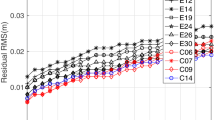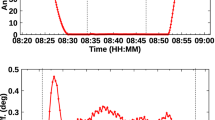Abstract
A geostationary (GEO) satellite may serve as a navigation satellite, but there is a problem that maneuvers frequently occur and the forces are difficult to model. Based on the technique of determining satellite orbits by transfer, a predicted orbit with high accuracy may be achieved by the method of statistical orbit determination in case of no maneuver force. The predicted orbit will soon be invalid after the maneuver starts, and it takes a long time to get a valid orbit after the maneuver ends. In order to improve ephemeris usability, the method of rapid orbit forecasting after maneuvers is studied. First, GEO satellite movement is analyzed in case of maneuvers based on the observation from the orbit measurement system by transfer. Then when a GEO satellite is in the free status just after maneuvers, the short arc observation is used to forecast the orbit. It is assumed that the common system bias and biases of each station are constant, which can be obtained from orbit determination with long arc observations. In this way, only 6 orbit elements would be solved by the method of statistical orbit determination, and the ephemeris with high accuracy may be soon obtained. Actual orbit forecasting with short arc observation for SINOSAT-1 satellite shows that, with the tracking network available, the precision of the predicted orbit (RMS of O-C) can reach about 5 m with 15 min arc observation, and about 3 m with 30 min arc observation.
Similar content being viewed by others
References
Ai G X, Shi H L, Wu H T, et al. A positioning system based satellite communication and the Chinese Area Positioning System (CAPS). Chin J Astron Astrophy, 2008, 8(6): 611–630
Ai G X, Shi H L, Wu H T, et al. The principal of the positioning system based on communication satellites. Sci China Ser G-Phys Mech Astron, 2009, 52(3): 472–488
Li X H, Wu H T, Bian Y J, et al. Satellite virtual atomic clock with pseudorange difference function. Sci China Ser G-Phys Mech Astron, 2009, 52(3): 353–359
Lu X C, Wu H T, Bian Y J, et al. Signal structure of the Chinese Area Positioning System. Sci China Ser G-Phys Mech Astron, 2009, 52(3): 412–422
Li Z G, Ai G X, Shi H L, et al. Method of orbit measurement and determination by transfer. PRC Patent, ZL 200310102197.1, 2006-07-05
Li Z G, Qiao R C, Feng C G. Ranging and two-way satellite time transfer. J Spacecr TT C Technol,, 2006, 25(3): 1–6
Li Z G, Yang X H, Shi H L, et al. A new method for determination of satellite orbits by transfer. Sci China Ser G-Phys Mech Astron, 2009, 52(3): 384–392
Yang X H, Li Z G, Hua A H. Analysis of two-way satellite time and frequency transfer with C-band. In: Proceedings of 2007 IEEE Int Freq Contr Symp. New York: IEEE, 2007. 901–903
Li J S. Satellite Precision Orbit Determination. Beijing: People’s Liberation Army Press, 1990
Tapley B D, Schutz B E, Born G H. Statistical Orbit Determination. Burlington: Elsevier Academic Press, 2004. 285–317
Su H. Precise orbit determination of global navigation satellite system of second generation (GNSS-2). Doctor Dissertation. Munich: University FAF Munich, 2000
Author information
Authors and Affiliations
Corresponding author
Additional information
Supported by the National High Technology Research and Development Program of China (Grant No. 2006AA12Z322), the National Basic Research Program of China (Grant No. 2007CB815503), and the West Light Program of Chinese Academy of Sciences (Grant No. 2007LH01)
Rights and permissions
About this article
Cite this article
Yang, X., Li, Z., Feng, C. et al. Methods of rapid orbit forecasting after maneuvers for geostationary satellites. Sci. China Ser. G-Phys. Mech. Astron. 52, 333–338 (2009). https://doi.org/10.1007/s11433-009-0066-5
Received:
Accepted:
Published:
Issue Date:
DOI: https://doi.org/10.1007/s11433-009-0066-5




